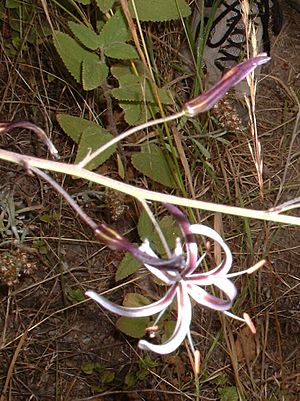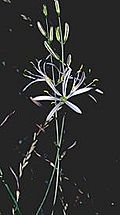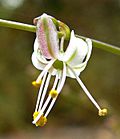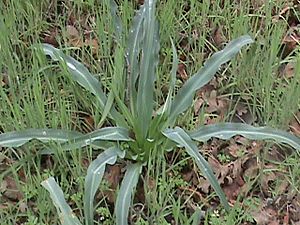Chlorogalum facts for kids
Quick facts for kids ChlorogalumSoap plant, Amole |
|
|---|---|
 |
|
| Chlorogalum pomeridianum Wavy-leafed soap plant |
|
| Scientific classification |
|
| Kingdom: | Plantae |
| Clade: | Tracheophytes |
| Clade: | Angiosperms |
| Clade: | Monocots |
| Order: | Asparagales |
| Family: | Asparagaceae |
| Subfamily: | Agavoideae |
| Genus: | Chlorogalum (Lindl.) Kunth |
| Synonyms | |
|
|
The common names soap plant, soaproot and amole all mean the plant group called Chlorogalum. These plants grow naturally in western North America. You can find them from Oregon down to Baja California. Most of them live in California. People call them "soap plants" because they were used like soap.
Soap plants are perennial plants. This means they live for more than two years. They grow from bulbs. These bulbs can be long or round, depending on the type. The bulbs can be white or brown. Most have a tough, fibrous outer layer. Their flowers grow on a tall central stem. The flowers look like they have six separate petals. They also have six prominent stamens.
Contents
How Scientists Group Soap Plants
Scientists like to group living things. This helps them understand how plants are related. The Chlorogalum genus has been placed in different plant families over time. Today, scientists mostly agree it belongs to the Asparagaceae family. This family also includes asparagus and agave plants. This grouping is based on looking at the plants' DNA.
Types of Soap Plants
There are five different types of soap plants. Most of them grow in specific, small areas. They do not usually overlap much. However, the Wavy-leafed Soap Plant (Chlorogalum pomeridianum) is different. It grows in almost all the same places as the other types. It is also the most common soap plant.
| Image | Scientific name | Common Name | Where it Grows |
|---|---|---|---|
 |
Chlorogalum angustifolium | Narrow-leaf Soap Plant | Inner north Pacific Coast Ranges of California and southern Oregon. Also in the Sierra Nevada foothills. |
 |
Chlorogalum grandiflorum | Red Hills Soaproot | North and central Sierra Nevada foothills. |
| Chlorogalum parviflorum | Small-flowered Soaproot | South coastal California, south of Santa Barbara. Also into Baja California. | |
 |
Chlorogalum pomeridianum | Wavy-leafed Soap Plant | Almost anywhere in California, except high mountains and deserts. Also in southwestern Oregon. |
 |
Chlorogalum purpureum | Purple Amole | Outer South Coast Ranges of California. South of Monterey Bay and north of Santa Barbara. |
Uses of Soap Plants
People have found many uses for soap plants over time.
As Soap
The fibers around the bulb were used to make small brushes. The juices from the bulbs could also be used as a kind of glue. Native Americans and early European settlers used soap plants for washing. Two types, C. pomeridianum and C. angustifolium, were especially popular. The bulbs contain natural chemicals called saponins. These saponins create a lather, or foam, when mixed with water. This is why the plant works like soap. It was often used for washing hair. People believed C. pomeridianum helped with dandruff.
For Food
The young leaves of some soap plant types can be eaten. However, the saponins in the bulbs make them poisonous if eaten raw. But saponins are not easily absorbed by the body. They can also be destroyed by cooking the bulbs very well. The Miwok and Chumash people would roast and eat the bulbs in winter. In 1847, a member of the Donner Party wrote about eating roots that tasted like sweet potatoes. These were likely C. pomeridianum bulbs.
Saponins are much more harmful to some animals than to humans. Fish are very sensitive to them. Because of this, the bulb juices were used to stun or kill fish. This made them easier to catch.
For Medicine
The bulbs also had different medicinal uses. They were used externally, meaning on the outside of the body. For example, they could be made into a poultice. This was used as an antiseptic or to help with rheumatism. They were also used internally. People drank special teas made from the bulbs. These teas were used as a diuretic, a laxative, or to help with stomachaches.
For Fishing
Many Native American tribes in California used soaproot. They would use it, or roots from yucca plants, to stun fish. They would crush the roots into a powder. Then they mixed the powder with water to make a foam. This foamy water was added to a stream. It would stun or kill the fish. Then the fish could be easily collected from the water's surface. Tribes like the Lassik, the Luiseño, and the Mattole used this method.
See also
 In Spanish: Chlorogalum para niños
In Spanish: Chlorogalum para niños


